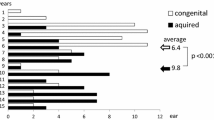Abstract
The purpose of this study was to investigate the characteristics of external auditory canal cholesteatoma (EACC) in children through evaluation of the clinical and radiologic features as well as treatment outcomes. The clinical records were retrospectively reviewed for children under 15 years of age diagnosed with spontaneous EACC between March 2004 and December 2011. The clinical data of adults diagnosed with spontaneous EACC during the same period were evaluated to compare with EACC in children. Eight patients (3 males and 5 females) with pediatric EACC and 18 patients (7 males and 11 females, 20 ears) with adult EACC were included within the boundary of the study. The mean ages were 12.4 years (age range 9–15) for pediatric EACC and 49.8 years (age range 29–79) for adult EACC patients. Follow-up periods ranged from 8 to 86 months (mean 32.5 ± 8.62) in pediatric EACC and from 6 to 72 months (mean 22.2 ± 5.36) in adult EACC. Pediatric EACC, showed involvement most commonly in the posterior wall, while the inferior wall was most commonly involved in adult EACC. Pediatric EACC tended to show a more focal involvement and was not as extensive as adult EACC. Extension into the adjacent structures was similar in both groups, but bony destruction was more common in the adult group. Two children and eight adult patients were treated with surgery, but four adult cases needed more extensive surgical treatment because their disease was widely spread to included areas such as the mastoid segment of facial nerve and the temporomandibular joint. Six pediatric cases treated with conservative management showed no progression of disease on physical examination at the last visit, but two cases of adults progressed and required canaloplasty. Pediatric EACC shows less aggressive behavior compared to adult EACC. Adequate management may work better in pediatric than in adult EACC, even though the treatment modality is conservative management.


Similar content being viewed by others
References
Anthony PF, Anthony WP (1982) Surgical treatment of external auditory canal cholesteatoma. Laryngoscope 92:70–75
Owen HH, Rosborg J, Gaihede M (2006) Cholesteatoma of the external ear canal: etiological factors, symptoms and clinical findings in a series of 48 cases. BMC Ear Nose Throat Disord 6:16
Holt JJ (1992) Ear canal cholesteatoma. Laryngoscope 102:608–613
Pipergerdes JC, Kramer BM (1980) Keratosis obturans and external auditory canal cholesteatoma. Laryngoscope 90:383–391
Palva A, Karma P, Kärjä J (1977) Cholesteatoma in children. Arch Otolaryngol 103:74–77
Shohet JA, De Jong AL (2002) The management of pediatric cholesteatoma. Otolaryngol Clin N Am 35:841–851
Yoon YH, Park CH, Kim EH, Park YH (2008) Clinical characteristics of external auditory canal cholesteatoma in children. Otolaryngol Head Neck Surg 139:661–664
Cheng YF, Chiao AS, Lien CF (2005) Pediatric external canal cholesteatoma with extensive invasion into the mastoid cavity. Int J Pediatr Otorhinolaryngol 69:561–566
Quantin L, Fernandez SC, Moretti J (2002) Congenital cholesteatoma of external auditory canal. Int J Pediatr Otorhinolaryngol 62:175–179
Choi JH, Woo HY, Yoo YS, Cho KR (2011) Congenital primary cholesteatoma of external auditory canal. Am J Otolaryngol 32:247–249
Naim R, Linthicum R, Shen T, Bran G, Horman K (2005) Classification of the external auditory canal cholesteatoma. Laryngoscope 115:455–460
Paparella MM, Jung TT (1984) Intact-bridge tympanomastoidectomy. Otolaryngol Head Neck Surg 92(3):334–338
Bujia J, Holly A, Antoli-Candela F, Tapia MG, Kastenbauer E (1996) Immunobiological peculiarities of cholesteatoma in children: quantification of epithelial proliferation by MIB1. Laryngoscope 106:865–868
Dornelles Cde C, da Costa SS, Meurer L, Rosito LP, da Silva AR, Alves SL (2009) Comparison of acquired cholesteatoma between pediatric and adult patients. Eur Arch Otorhinolaryngol 266:1553–1561
Dubach P, Mantokoudis G, Banz Y, Caversaccio M, Senn P (2013) Histopathologic case of the month—idiopathic ear canal cholesteatoma. Otol Neurotol 34(5):e40–e41
Naim R, Shen T, Riedel F, Bran G, Sadick H (2005) Regulation of apoptosis in external auditory canal cholesteatoma by hepatocyte growth factor/scatter factor. ORL 67:45–50
Naim R, Sadick H, Schafer C, Hormann K (2004) External auditory canal cholesteatoma: analysis of the integrity of the tissue structure. Int J Mol Med 14:601–604
Lin YS (2009) Surgical results of external canal cholesteatoma. Acta Otolaryngol 129:615–623
Makino K, Amatsu M (1986) Epithelial migration on the tympanic membrane and external canal. Arch Otorhinolaryngol 243:39–42
Dubach P, Mantokoudis G, Caversaccio M (2010) Ear canal cholesteatoma: meta-analysis of clinical characteristics with update on classification, staging and treatment. Curr Opin Otolaryngol Head Neck Surg 18:369–376
Bonding P, Raven T (2008) Primary cholesteatoma of the external auditory canal: is the epithelial migration defective? Otol Neurotol 29:334–338
Terayama Y, Sakata A, Murata Y, Harada K, Ohashi M (2010) Burow’s solution treatment for external auditory canal and mastoid cavity cholesteatoma. Nihon Jibiinkoka Gakkai Kaiho 113(6):549–555
Rauch F (2006) Watching bone cells at work: what we can see from bone biopsy. Pediatr Nephrol 21:457–462
Author information
Authors and Affiliations
Corresponding author
Rights and permissions
About this article
Cite this article
Kim, C.W., Baek, SH., Lee, SH. et al. Clinical characteristics of spontaneous cholesteatoma of the external auditory canal in children comparing with cholesteatoma in adults. Eur Arch Otorhinolaryngol 271, 3179–3185 (2014). https://doi.org/10.1007/s00405-013-2820-6
Received:
Accepted:
Published:
Issue Date:
DOI: https://doi.org/10.1007/s00405-013-2820-6




